A Novel Collocation Method for Numerical Solution of Hypersingular Integral Equation with Singular Right-Hand Function
Abstract
In this study, the Fredholm hypersingular integral equation of the first kind with a singular right-hand function on the interval [−1, 1] is solved. The discontinuous solution on the domain [−1, 1] is approximated by a piecewise polynomial, and a collocation method is introduced to evaluate the unknown coefficients. This method, which can be applied to both linear and nonlinear integral equations, is very simple and straightforward. The presented illustrations relate that the results are very accurate compared to the other methods in the literature.
1. Introduction
Hypersingular integral equations (HSIEs) are widely presented in different fields of physics and engineering such as crack problems in fracture mechanics [1], radiation problems involving thin-submerged plates [2–4], antenna theory [5], aerodynamics [6, 7], elliptic wing case in Prandtl’s equation [8, 9], electrodynamics, and quantum physics [6].
Many two-dimensional boundary value problems in mathematical physics can be formulated as HSIEs. It is investigated that how the problems such as two-dimensional flow post a rigid plate in an infinite fluid, acoustic scattering by a hard plate, water wave interaction with thin impermeable barriers, stress fields around cracks, certain specific problems involving cracks in an elastic medium and scattering of surface water waves by obstacles in the form of thin barriers, and some other issues give rise to HSIEs (see [7]). There are two strategies to solve these problems. The direct methods in which the problem is solved using the method of solving differential equations are finite difference methods [10] and Runge-Kutta-embedded methods [11]. Another robust tool is indirect methods in which the differential equation is transformed into an equivalent equation such as a HSIE. The numerical solutions for the second category is often less complicated.
In certain cases, there exist some analytical methods for solving HSIEs, but in general, there is no known analytical method. Thus, different numerical methods are introduced and developed for solving HSIEs [8, 9, 12–26].
Recently, a special class of Equation (1) was introduced under the assumption that the right-hand function f(x) possesses singularities at some points c1 < c2 < ⋯<cm−1 of the interval (−1, 1) [5, 6, 27]. In this case, the solution is not smooth in the integration domain. It was shown in [21] that if the right-hand function f(x) in Equation (1) belongs to a Hölder class, then, under some additional conditions on the boundaries, the solution can be represented as or u(x) = ((1 + x)/(1 − x))±1/2ϕ(x), where ϕ(x) is a smooth function. While, for the singular right-hand function f(x), the class of solutions for Equation (1) is not determined yet.
Authors in [28, 29] introduced a variant of the generalized Euler-Maclaurin summation formula for the product integration rule and applied it for approximating weakly singular integrals. Also, with the expansion of the theory of fractional calculus in recent years, many attempts have been made to use fractional calculus to solve singular integral equations. These methods are suitable for solving weakly singular integral equations, but they cannot be used for a stronger singular integral equations such as HSIEs.
Recently, an iterative projection method is presented for solving linear and nonlinear HSIEs with non-Riemann integrable functions on the right-hand side [25]. They applied the continuous method and presented the convergence of the proposed method based on the Lyapunov stability theory. Not many papers have been published to solve the Equation (1) with singular right-hand function yet. To avoid the complexity of the method presented in [25] in the present study, we consider a simple collocation method for the numerical solution of HSIE (Equation (1)) with the singular right-hand function. The most important advantage of our method is its simplicity and adaptability to different states of the right-hand function. The rest of this paper is organized as follows: in Section 2, the piecewise polynomial collocation method is introduced and applied to the proposed linear and nonlinear hypersingular integral equation. The numerical illustrations are presented in Section 3, and finally, a brief conclusion appeared in Section 4.
2. Method of Solution
Definition 1. We define the Cauchy and Hadamard integrals, respectively, as follows
Theorem 2. The Cauchy and Hadamard integrals defined in Equations (5) and (6) are calculated as follows:
Proof. By the definition of Cauchy integral (Equation (5)), we have
Also, by the definition of Hadamard integral (Equation (6)), we have
2.1. Application to Linear HSIE
We select N + 1 distinct points xr0 < xr1 < ⋯<xrN on the jth subinterval (cr−1, cr), r = 1, 2, ⋯m.
Remark 3. Due to Definition 1, the Hadamard integrals Hi(x, t), i = 0, 1, ⋯N are linearly independent functions. Also, the points are distinct and xrs ≠ cj. Then, from Haar property for independent functions, we conclude that |A| ≠ 0. This means that the linear system (Equation (16)) has a unique solution.
2.2. Application to Nonlinear HSIE
3. Numerical Illustrations
Example 5. Consider the following linear HSIE of the first kind,
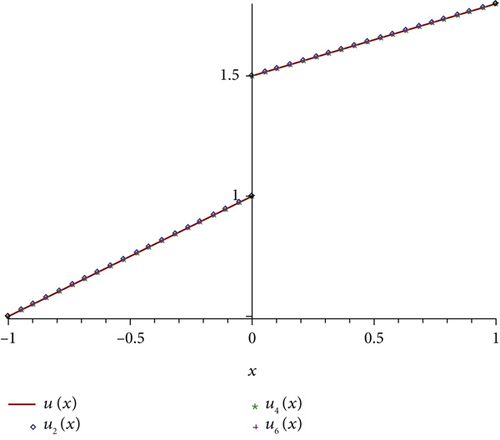
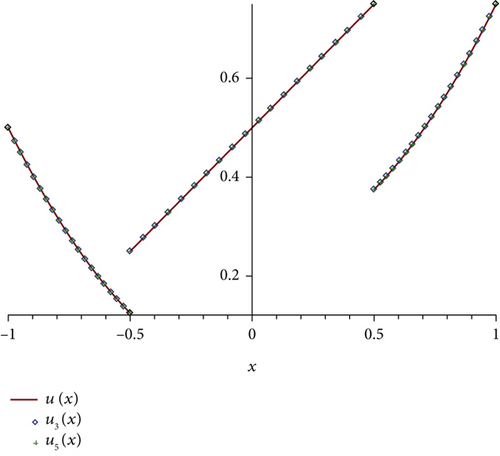
Example 7. For the next example, we suppose the following nonlinear HSIE of the first kind,
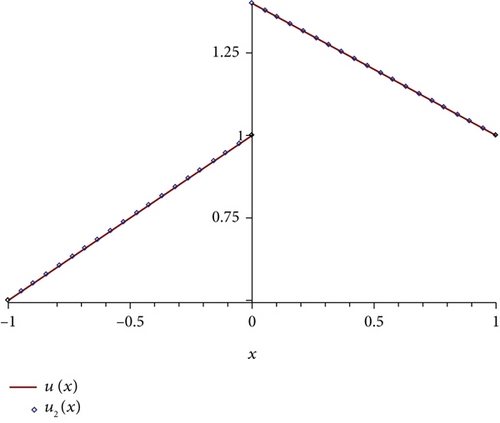
The right-hand function f(x) is singular at three points c0 = −1, c1 = 0, and c2 = 1, while the exact solution is not known. The graph for approximate solutions for different values of N is plotted in Figure 4.
Example 8. Suppose the following nonlinear HSIE of the first kind,
Remark 9. According to the illustrated examples, we can see that when the solution of the HSIE is polynomial, the present method produces the exact solution of the problem. In case the exact solution is not available, the numerical approximations converge to each other by increasing N (see Examples 7 and 8). Comparison of numerical results with the results of [25] show that the present method is very efficient.
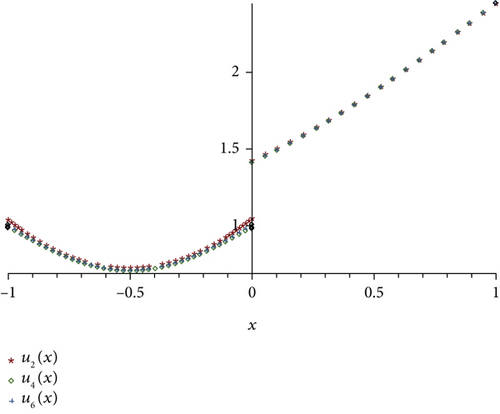
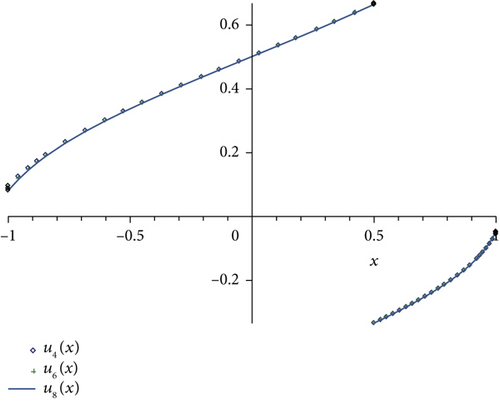
4. Conclusion
In this study, we have developed a novel collocation method for solving the first kind of hypersingular integral equations of the first kind with a singular right-hand function. The solution is considered as a piecewise polynomial on the integration domain, and the unknown coefficients are determined by solving an algebraic system of equations. The new method applies to both linear and nonlinear integral equations. This method covers a wide range of singular integral equations with different types of singularities on the right-hand function. It can also be applied for supersingular integral equations with singular right-hand function.
For further research in this field, it is suggested that the class of the solution space of the equation be analyzed analytically based on the type of singularity of the right-hand function.
Conflicts of Interest
The authors declare that they have no conflict of interest.
Open Research
Data Availability
No underlying data was collected or produced in this study.




